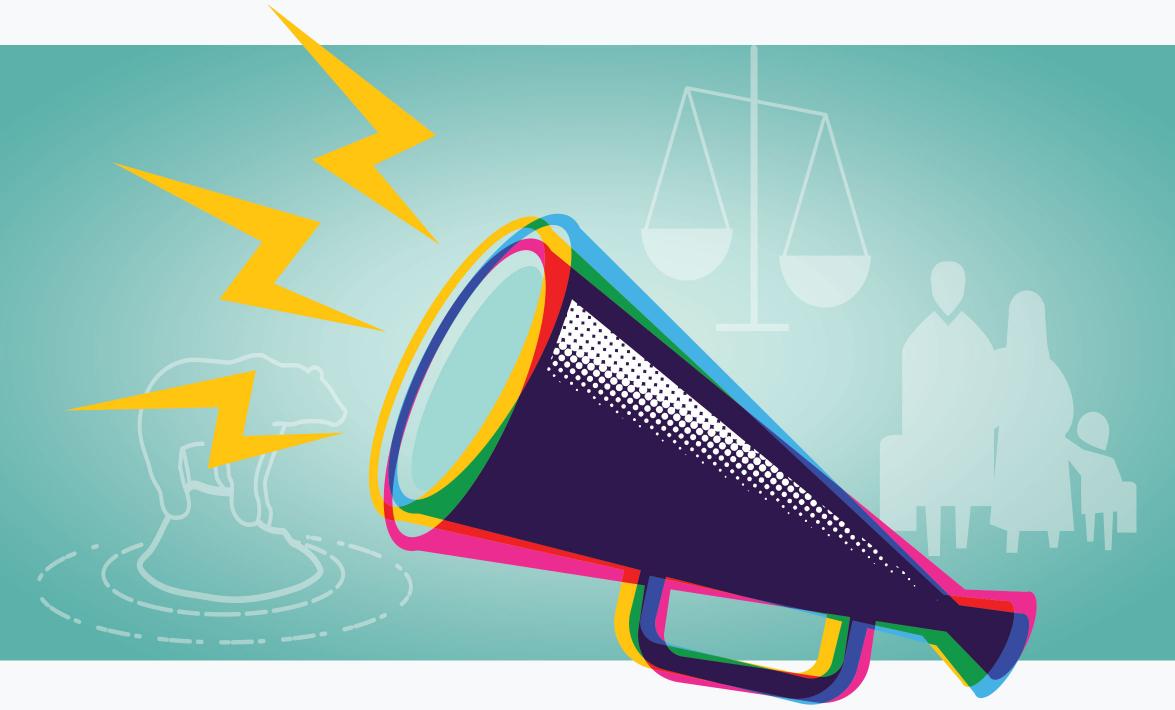
Change It Up
Varied voices, disciplines, and approaches fuel social and behavioral change communication.
HIV testing. Family planning. Bed net use. The field of social and behavior change communication has long had success in driving such health-positive behaviors.
Its evolution has catalyzed partnerships with the private sector, advocacy groups, and public health practitioners to focus on urgent issues such as the climate crisis, migration, misinformation, and gender equity.
The third International SBCC Summit*, in Marrakech, Morocco, will convene an expected 1,500 members of this diverse community, representing over 90 countries.
Organized by the Johns Hopkins Center for Communication Programs and local and international partners, the summit will explore applications of social and behavior change communication to priority development and health issues, says Leanne Wolff, summit coordinator and a CCP senior program officer.
Climate crisis messaging, for example, involves “using advocacy to change policy, communicating urgency at the community and individual level, and developing programs that support normative change,” Wolff says.
She hopes the Summit will convey “the breadth of social and behavioral change communication, and how people are using it across disciplines and topics rather than treating it as a siloed approach.”
*UPDATE: Given the latest WHO guidance, the unpredictable nature of COVID-19, and the growing number of travel restrictions, organizers have postponed this event.

Crises in the Classroom
After 30+ sessions, HELP is still needed—and as popular as ever.
Gil Burnham recalls a question the late International Health Professor Tim Baker asked in his interview for a faculty position at the School: “Do you know anything about refugees?”
As a matter of fact, he did.
Burnham, MD, PhD, MSc, joined the School in 1991 straight from 15 years in Malawi, where he managed rural health services. During that time, a civil war in Mozambique sent hundreds of thousands of refugees to Malawi.
Soon after joining the faculty, Burnham worked with the International Committee of the Red Cross to cosponsor a short course at the School to offer public health training to humanitarian workers. The course—Health Emergencies in Large Populations—debuted in the 1995 Summer Institutes and is now offered in the Winter Institutes as well. Burnham will teach it for the 35th time in July.
HELP focuses on humanitarian crises mainly caused by natural disasters and conflict. Its students include humanitarian aid professionals as well as health care providers, lawyers, and journalists.
“I’m always proud that every year many students decide to pursue a career in public health … an interest sparked in some way by the course,” says Burnham, who estimates that HELP’s alumni number almost 1,000 from over 70 countries. Graduates have gone on to leadership roles in humanitarian organizations, some of whom Burnham encounters in the course of his work.
Tsihya Subayi, a World Bank health specialist and 1998 HELP graduate, ran into Burnham several years ago in Burkina Faso. She was working on a river blindness control program, and Burnham came to give a talk. “Immediately he recognized me,” says Subayi.
Particularly in her work with refugees, Subayi finds that HELP lessons remain relevant—being sensitive to cultural norms, for example. “The course not only gave me knowledge, but increased my sensitivity to certain situations.”
Over the years, HELP—now codirected by Mija-Tesse Ververs, MMed, MPH, RD, senior associate in International Health—has responded to shifts in the public health landscape (more focus on NCDs, communications, and security) and made use of new online education platforms (MOOC modules).
What hasn’t changed? Burnham’s enthusiasm. “Every year I have a lot of nervous anticipation [before the course]” he says. “I’m always excited about it.”
In Case You Missed It
The Word on Wolfe Street
Follow
The U.S. Customs and Border Protection agency’s plan to improve medical screenings of migrants in CBP custody is “beyond disappointing” and “incredibly frustrating,” says Josh Sharfstein in a January 1 CNN story.
Read
The ongoing financial burden of breast cancer medical care can exact a “crippling” toll, eating into patients’ discretionary spending and whittling away at retirement savings, Lorraine Dean says in a January 21 Forbes story.
Listen
In a December 27 Here & Now story, Jeff Hardesty addresses tobacco and vaping industry support of a new federal law that raises the legal age to buy tobacco products from 18 to 21.
"I have to believe there’s been some recognition among company leadership that raising the minimum age is the lesser of evils when compared to a flavor ban or restriction.”
Share This: How Do You Recharge?

Susan Gross
Population, Family and Reproductive Health
Hiking! It is important for me to take a break and unplug in the outdoors. I love the fresh air and peaceful feeling experienced while walking along a trail. Nature always revitalizes me.

Victoria Chou
International Health
I have a conversation with my kids, ages 4 and 6. Their worldview is refreshingly simple, despite comments that seem profound at times. The outcome may be a good belly laugh or remembering when I had similar thoughts!
EVENTS WATCH
Working Well
3 Questions for Ron Goetzel, PhD, MA
Workplace health promotion programs can boost employees’ health and well-being and, in many cases, achieve cost savings, says Ron Goetzel, director of the School’s Institute for Health and Productivity Studies. At the Art and Science of Health Promotion Conference, April 20–24, Goetzel will teach students from business and academia proven methods to measure such programs’ performance.
How common are workplace health promotion programs in the U.S.?
About 80% of companies with at least 200 employees say they have them. That might mean flu shots or an online wellness portal as part of a health plan. In terms of a comprehensive, evidence-based program that’s likely to improve population health, it’s around 15%.
What is a major barrier to effective programs?
Lack of investment. The U.S. spends $3.5 trillion on health care, mainly to treat poor health outcomes. The investment that companies put into health promotion and prevention, estimated at $200 per year per employee, is microscopic.
What makes a successful workplace health promotion program?
Based on research, at the top of the list is leadership commitment to a culture of health as part of an organization’s strategic plan.
